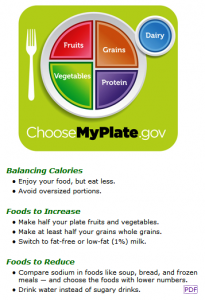The 2015 Dietary Guidelines’ hidden advice about sugary drinks: definitely there, but hard to find
I’m indebted to Maria Godoy of NPR’s The Salt for pointing out where in the new 2015 Dietary Guidelines you can find advice about cutting down on sugary drinks. As she puts it, this is easy to miss.
Here’s my wonky analysis.
In my post about the 2015 Dietary Guidelines, I noted that they are unambiguous about the need to reduce added sugars to 10% or less of calories. But what they say about cutting down on sugary drinks—the leading source of sugars in US diets—is buried deep in the text. Fortunately, Deborah Noble of slowfoodfast.com has performed a great public service by producing the 2015 Dietary Guidelines in a searchable pdf format.Here’s where to find advice about cutting down on sugary drinks:
The Executive Summary: See under “Cross-Cutting Topics of Public Health Importance:”
Similarly, added sugars should be reduced in the diet and not replaced with low-calorie sweeteners, but rather with healthy options, such as water in place of sugar-sweetened beverages.
Figure 2-10 explains:
The major source of added sugars in typical U.S. diets is beverages, which include soft drinks, fruit drinks, sweetened coffee and tea, energy drinks, alcoholic beverages, and flavored waters.
Reading the Figure tells you that beverages comprise a whopping 47% of added sugars (closer to half if you add in sweetened milks, teas, and coffees). The text following the Figure says:
Shift to reduce added sugars consumption to less than 10 percent of calories per day: Individuals have many potential options for reducing the intake of added sugars. Strategies include choosing beverages with no added sugars, such as water, in place of sugar-sweetened beverages, reducing portions of sugar-sweetened beverages, drinking these beverages less often, and selecting beverages low in added sugars.
Strategies? How about just saying: “Cut down on sugary drinks” or “Drink water instead of sugary drinks.”
Figure ES-1 in the Executive Summary illustrates the 2015-2020 Dietary Guidelines for Americans at a Glance. All it says is:
Limit calories from added sugars…Consume an eating pattern low in added sugars…Cut back on food and beverages higher in these components to amounts that fit within healthy eating patterns.
Figure 3.2 shows Implementation of the Guidelines through MyPlate: “Drink and eat less…added sugars,” but nothing about sugary drinks.
This circumspection is weird. Clear, straightforward advice to cut down on sugary beverages has plenty of historical precedent.
Both Figures ES-1 and 3.2 are most certainly derived from a USDA graphic on the MyPlate website (dated January 2016). This says flat out:
Drink water instead of sugary drinks.
This statement, in turn, derives from:
- The precepts issued with the 2010 Dietary Guidelines in January 2011
- The statements issued with the MyPlate graphic in June 2011

- The USDA’s May 2012 tip for making better beverage choices.
The 2015 DGAC (Dietary Guidelines Advisory Committee) repeatedly urged limits on consumption of sugar-sweetened beverages. Statements like this one, for example, appear throughout the document:
To decrease dietary intake from added sugars, the U.S. population should reduce consumption of sugar-sweetened beverages.
Why did the USDA and HHS writing committee choose to waffle about his point?
This cannot be an accident. It must be deliberate. And it can have only one explanation: politics.

